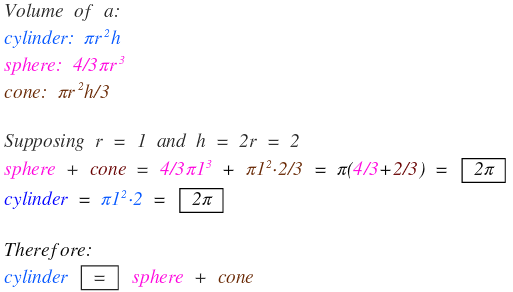Bar, Ball, Cone
A chocolate shop sells its products in 3 different shapes: a cylindrical bar, a spherical ball, and a cone. These 3 shapes are of the same height and radius, as shown in the picture. Which of these choices would give you the most chocolate?
I. A full cylindrical bar or II. A ball plus a cone
This section requires Javascript.
You are seeing this because something didn't load right. We suggest you, (a) try
refreshing the page, (b) enabling javascript if it is disabled on your browser and,
finally, (c)
loading the
non-javascript version of this page
. We're sorry about the hassle.
6 solutions
This is my own solution but I closed my old account. I am using a new account now.
The question is misleading. You should have also labeled the height components of each figure since I completely ignored height for the sphere: I get that you put "all 3 shapes" but still I do not associate height to a sphere. The sphere forces the height to be 2 times the radius. Hence, I got "not enough information" for my answer-wrong.
Let us compute the volume of the two options and then compare.
Option 1: the cylindrical bar
The standard formula for the volume of a cylinder is π r 2 h . In this case h=2r. Substituting this value in, the total volume for option 1 is 2 π r 3
Option 2: the ball and the cone
The standard formula for the volume of a ball (a sphere) is 3 4 π r 3 . The standard formula for the volume of a cone is 3 1 π r 2 h . h=2r so the volume of the cone is 3 2 π r 3 Thus the total volume for option 2 is 3 4 π r 3 + 3 2 π r 3 = 2 π r 3
Clearly the volume is the same for option 1 and option 2, thus it does not matter which option is chosen.
Yes, that's exactly correct.
Log in to reply
Exactly where does it say h=2r in the problem? It says "These 3 shapes are of the same height and radius," but never specifies h=2r
Log in to reply
Well, the height of the sphere is its diameter, 2r. Would you agree?
Log in to reply
@Worranat Pakornrat – Ahhh yes...guess that didn't click in my brain at 5am...lol
It's due to the Cavaliere's Principle. When it has same height and radius, the sum of the volume of a sphere and a cone is the same as the volume of a cilinder.
Can you show us how you apply Cavalieri's Principle here... it does not seem straightforward.
Thank you for your solution. I used to read about this concept a long time ago (with the half sphere visualization), but I didn't think it'd work for a whole sphere, too.
I did not want to work out the volumes of all the shapes, so I did this instead.
The volume of the cylinder is equal to the volume of the sphere plus two congruent cones of height r and base radius r. This is provable from a proof of the volume of a sphere.
All that remains to be shown is whether the volume of the two cones is greater than the single cone of double the height. It can be seen that 3 1 π r 2 ⋅ 2 r = 2 ( 3 1 π r 2 ⋅ r ) and therefore the volume of the cylinder is equal to the sum of the volume of the cone and the sphere.
With h = 2 r,
Pi (r^2) h = (4/ 3) Pi (r^3) + (1/ 3) Pi (r^2) h
as 2 = 4/ 3 + 2/ 3
Same total volume.

Volume of the cylindrical bar: V c y l i n d e r = π r 2 h = π ( 1 2 ) ( 2 ) = 2 π
Volume of spherical ball: V s p h e r e = 3 4 π r 3 = 3 4 π ( 1 3 ) = 3 4 π
Volume of cone: V c o n e = 3 1 π r 2 h = 3 1 π ( 1 2 ) ( 2 ) = 3 2 π
Compare:
V c y l i n d e r = V s p h e r e + V c o n e
2 π = 3 4 π + 3 2 π
2 π = 2 π
∴ B o t h o p t i o n s h a v e t h e s a m e a m o u n t .